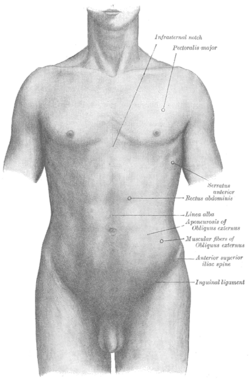Inguinal ligament
| Inguinal ligament | |
|---|---|

Inguinal ligament is labeled at bottom right.
|
|

Structures passing behind the inguinal ligament. Frontolateral view of the right side of the pelvis.
|
|
| Details | |
| From | anterior superior iliac spine |
| To | pubic tubercle |
| Identifiers | |
| Latin | Ligamentum inguinale |
| TA | A04.5.01.009 |
| FMA | 19855 |
|
Anatomical terminology
[]
|
|
The inguinal ligament (Poupart's ligament or groin ligament) is a band running from the pubic tubercle to the anterior superior iliac spine. Its anatomy is very important for operating on hernia patients.
It forms the base of the inguinal canal through which an indirect inguinal hernia may develop.
The inguinal (crural) ligament runs from the anterior superior iliac crest of the ilium to the pubic tubercle of the pubic bone. It is formed by the external abdominal oblique aponeurosis and is continuous with the fascia lata of the thigh.
There is some dispute over the attachments.
Structures that pass deep to the inguinal ligament include:
The midpoint of inguinal ligament is midpoint between the anterior superior iliac spine and pubic tubercle.
The ligament serves to contain soft tissues as they course anteriorly from the trunk to the lower extremity. This structure demarcates the superior border of the femoral triangle. It demarcates the inferior border of the inguinal triangle.
The midpoint of inguinal ligament is halfway between the anterior superior iliac spine and pubic tubercle. It's the landmark for the femoral nerve. The mid inguinal point is halfway between the anterior superior iliac spine and pubic symphysis. It's the landmark for femoral artery.
It is also referred to as Poupart's ligament, because François Poupart gave it relevance in relation to hernial repair, calling it "the suspender of the abdomen" (French: "le suspenseur de l'abdomen"). It is sometimes termed the Fallopian ligament. Colles' ligament is reflex ligament not inguinal ligament.
...
Wikipedia
